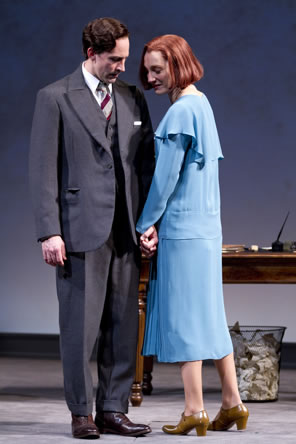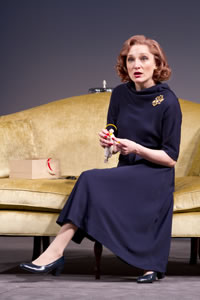Strange Interlude
A Marathon of a Play Leaving Us
Breathless in the Presentation
By Eugene O'Neill
Shakespeare Theatre Company, Sidney Harman Hall, Washington, D.C.
Tuesday, April 10, 2012, Seats C–119&120 (far left front orchestra)
Directed by Michael Kahn
I'm not about to pretend I know anything about Eugene O'Neill. I've read more about him than by him, and that, frankly, scared me away from him. But as this seldom-performed piece was part of our Shakespeare Theatre Company annual subscription, I could no longer hide from my destined intersection with O'Neill.
I'm the better for it. This play is long-winded and populated with forced profundities, but O'Neill in Strange Interlude nevertheless ingeniously crafted an eight-character study with a taut plot. What might have been little more than a soap opera (after all, the original script clocked in at more than five hours) crackled more as a mystery noir because O'Neill so richly drew the characters and STC's cast so endearingly played them.

Baylen Thomas as Ned Darrell and Francesca Faridany as Nina Leeds in the Shakespeare Theatre Company's production of Strange Interlude at Sidney Harman Hall. Below, Faridany as Nina almost 13 years later. Directed by Michael Kahn and costumed by Jane Greenwood, with hair and wig designs by Tom Watson, the characters aged 25 years in this Eugene O'Neill-crafted epic of American life. Photos by Scott Suchman, Shakespeare Theatre Company.
This was a pet project of director Michael Kahn, STC's artistic director, and he got permission from the O'Neill estate to trim the play, which O'Neill finished in 1923 but didn't produce on Broadway until 1928, when it won the Pulitzer Prize for drama. Even trimmed, the play, which started at 7:30 p.m., ended at 11:15 p.m. with a mad dash to the car park and the last Metro train (two intermissions totaled 25 minutes). It was a marathon for the audience (some of whom dropped out in the first intermission) and for the cast, too. The principals started showing their fatigue in the last couple of scenes, but they all deserve trophies for aging 25 years on stage and enduring so many conflicting emotions over their nine-act arcs while essentially doubling down on their characters.
O'Neill's most famously inventive device with Strange Interlude was weaving asides throughout the dialogue. Even as they carried on conversations with each other, the characters would think out loud for the audience. Shakespeare did this, but his asides and soliloquys weren't so integrated into the dialogue as O'Neill attempted in this play. Woody Allen also interwove inner thoughts with dialogue in the balcony scene of Annie Hall, but he used subtitles to tell us what Alvy and Annie were really thinking as they bumbled through their first date. Soap operas and movies use voice-over or omniscient narrators.
 The Strange Interlude cast had no such technical aids. They had to get by on their own ability to shift between outer person and inner person seamlessly to keep the play flowing without confusing the audience. At first, this audience, at least, was confused. It took me some 10 minutes of the first act before I realized the device in play. Even after I got it, I couldn't always discern between a character's inner thoughts and public expressions, especially at the 18-mile mark when Dr. Ned Darrell (Baylen Thomas playing with bottled up passion that would spew forth when shaken) seemed ready to reveal the big truth that forms the play's plotline. That may not have been Thomas flagging but intentional confusion as it served to ramp up the scene's tension and could have been O'Neill-cum-Kahn's intent to portray the thin ice between our private and public faces.
The Strange Interlude cast had no such technical aids. They had to get by on their own ability to shift between outer person and inner person seamlessly to keep the play flowing without confusing the audience. At first, this audience, at least, was confused. It took me some 10 minutes of the first act before I realized the device in play. Even after I got it, I couldn't always discern between a character's inner thoughts and public expressions, especially at the 18-mile mark when Dr. Ned Darrell (Baylen Thomas playing with bottled up passion that would spew forth when shaken) seemed ready to reveal the big truth that forms the play's plotline. That may not have been Thomas flagging but intentional confusion as it served to ramp up the scene's tension and could have been O'Neill-cum-Kahn's intent to portray the thin ice between our private and public faces.
It is because we see portrayed their inner and outer personas that Strange Interlude is an eight-character study, down to the smallest parts. But it is the play's ninth character that most influences the plot and behaviors of the rest: Gordon Shaw, an all-American scholar and athlete, all-around-great guy, and World War I aviator, who was killed two days before the Armistice. He only appears in the conversations and consciousness of the other characters who knew or heard of him, but through those reflections, we come to know him as well as we do any of the characters presented on the stage: They form his life.
Does that mean the public us is the real us, and the inner us disappears into oblivion over time? O'Neill suggests as much with Strange Interlude.
Nina, in an all-encompassing tour de force performance by Francesca Faridany, was Gordon's betrothed, and his death before they could consummate their love sends her into a spiral of depression and extreme behaviors. Her childhood friend was Charlie, a mama's boy and successful writer of silly society novels. Robert Stanton's handling of his asides was of a diamond cutter's expertise, his expression stiffening slightly when he transitioned into thinking mode, his voice sterner and more authoritative but reverting to the milquetoast posture and sing-song voice for his public interactions. In him we saw a man of physical, moral, emotional, and intellectual cowardice always needing a mother to rely on; but yet he had the keenest insights into the other characters, their behaviors, and his own self. Charlie did blur the line between inner and outer self when he got drunk for the first time and spilled his long-pent-up love for Nina, which Faridany's Nina so coolly ignored we couldn't be sure if Stanton was speaking an aside or not (again, a calculated confusion in the staging).
The vocalized subtitles shifted the drama that Strange Interlude started off aspiring to into the comedy that it really proved to be as we watched the characters gloss over in public what they were really thinking in private, especially Charlie, who privately felt overwhelmed by a life he couldn't control like one of his novels. Nina goes to work as a nurse at a veterans' hospital to find meaning in her life by having sex with as many of Gordon's fellow soldiers as she could. Ned is the medical director, and as a means of therapy works to get her married to Sam Evans, a shy, self-effacing young man in a subtly assured performance by Ted Koch. Having children should cure Nina, Ned believes, and she agrees though she doesn't love Sam. But when she learns that Sam's family has a history of insanity, Nina terminates that pregnancy and gets a different father for a new child that Sam believes is his. Being a father changes Sam, and he becomes a wealthy businessman.
The first half of the play is Nina's tragedy, and Faridany negotiated her character through her mental instability into a devious manipulator of the three men in her life: her trusty friend, her husband, and her lover, and she is confident that she will find true love and meaning in the son she and Sam name Gordon after the legendary Gordon Shaw. But the second half of the play is that son coming of age and how life reshapes not only Nina's perspectives but also two of the three men in her life (Charlie never changes). All the while, the truth of young Gordon's parentage burbles under the surface of the public action and plays out fully in the private action. When the truth is finally expressed, the climactic moment actually passes unnoticed by the character it most affects and, in the denouement, the three surviving principals settle into the public lives that their private lies have created. “Say lie,” Nina says early in the play, drawing out the word “l-i-i-e.” “Now say life. L-i-i-f-e. You see? Life is just a long drawn out lie with a sniffling sigh at the end.”
O'Neill applied his two-tiered treatment even to his minor characters, and every cast member played his or her own particular juggling act adeptly. Ted van Griethuysen's Professor Henry Leeds, Nina's father, appeared only in the first act, but his portrayal sprang to mind every time Nina mentioned her father thereafter. He had intervened in Gordon Shaw's intention to marry Nina, and the subsequent rift between father and daughter determined much of Nina's emotional state going forward. In van Griethuysen's portrayal we saw both genuine concern for Nina and his own selfishness warring with each other. Tana Hicken as Sam's mother looked like she stepped out of a Grant Wood painting. Was she a kindly old woman or as insane as she professed the rest of her family to be? Hicken gave us the former while leaving us considering the latter. Rachel Spencer Hewitt's Madeline, young Gordon's fiancée, could have been mere eye candy, for so she's regarded by most of the other characters. However, whereas Hewitt in her first scene was all public charm but privately an enterprising woman with a stubbornness to match Nina's manipulativeness, in the final act she merged her charming persona with the steely determination her previous asides had shown us. Jake Land played young Gordon as a 12-year-old, maturely handling the awkward lines O'Neill had given this boy growing up as the progeny of a lie he sensed but didn't understand. Land handed the portrayal off to Joe Short as college-age Gordon who confidently carried it to the finish.
Another key player of this production was Walt Spangler's set, a box-like white room with two doors set in an angle on the Harman Hall stage. Walking into the theater, we had the sense we were peering into a shadow box. The walls became a screen on which was depicted Gordon Shaw's demise and time passing between acts. Meanwhile, each scene's necessary furniture efficiently switched out via the trap door elevator. I have never liked Sidney Harman Hall for a lot of reasons, but this was the first time I've seen this theater perform to its professed potential.
Meanwhile, I'm now ready—eager, even—to take in more O'Neill. Along with his craftsmanship and wordplay, his prescience won me over. Strange Interlude was written in 1923, and its timeline effectively started from that point. Kahn and costume designer Jane Greenwood deserve credit for portraying the ensuing 25 years of American culture, but the underlying vision was O'Neill's. In his composing Charlie as an old-wealth novelist out of touch with his time, Ned as a self-absorbed doctor who finds redemption in life-saving science, Sam as a “self-made millionaire” who really made his millions by manipulating the wealth of others, and Nina as a fiercely independent woman claiming above all else possession of both her own soul and body, O'Neill depicted an America in the making.
Eric Minton
April 13, 2012
Comment: e-mail editorial@shakespeareances.com
Start a discussion in the Bardroom



 Find additional Shakespeareances
Find additional Shakespeareances